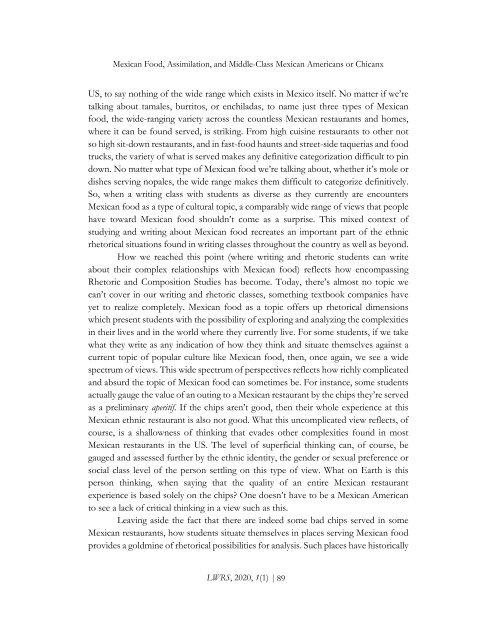LWRS June 2020 Volume 1, Issue 1
Inaugural Issue co-edited by Yndalecio Isaac Hinojosa and Isabel Baca
Inaugural Issue co-edited by Yndalecio Isaac Hinojosa and Isabel Baca
Create successful ePaper yourself
Turn your PDF publications into a flip-book with our unique Google optimized e-Paper software.
Mexican Food, Assimilation, and Middle-Class Mexican Americans or Chicanx<br />
US, to say nothing of the wide range which exists in Mexico itself. No matter if we’re<br />
talking about tamales, burritos, or enchiladas, to name just three types of Mexican<br />
food, the wide-ranging variety across the countless Mexican restaurants and homes,<br />
where it can be found served, is striking. From high cuisine restaurants to other not<br />
so high sit-down restaurants, and in fast-food haunts and street-side taquerias and food<br />
trucks, the variety of what is served makes any definitive categorization difficult to pin<br />
down. No matter what type of Mexican food we’re talking about, whether it’s mole or<br />
dishes serving nopales, the wide range makes them difficult to categorize definitively.<br />
So, when a writing class with students as diverse as they currently are encounters<br />
Mexican food as a type of cultural topic, a comparably wide range of views that people<br />
have toward Mexican food shouldn’t come as a surprise. This mixed context of<br />
studying and writing about Mexican food recreates an important part of the ethnic<br />
rhetorical situations found in writing classes throughout the country as well as beyond.<br />
How we reached this point (where writing and rhetoric students can write<br />
about their complex relationships with Mexican food) reflects how encompassing<br />
Rhetoric and Composition Studies has become. Today, there’s almost no topic we<br />
can’t cover in our writing and rhetoric classes, something textbook companies have<br />
yet to realize completely. Mexican food as a topic offers up rhetorical dimensions<br />
which present students with the possibility of exploring and analyzing the complexities<br />
in their lives and in the world where they currently live. For some students, if we take<br />
what they write as any indication of how they think and situate themselves against a<br />
current topic of popular culture like Mexican food, then, once again, we see a wide<br />
spectrum of views. This wide spectrum of perspectives reflects how richly complicated<br />
and absurd the topic of Mexican food can sometimes be. For instance, some students<br />
actually gauge the value of an outing to a Mexican restaurant by the chips they’re served<br />
as a preliminary aperitif. If the chips aren’t good, then their whole experience at this<br />
Mexican ethnic restaurant is also not good. What this uncomplicated view reflects, of<br />
course, is a shallowness of thinking that evades other complexities found in most<br />
Mexican restaurants in the US. The level of superficial thinking can, of course, be<br />
gauged and assessed further by the ethnic identity, the gender or sexual preference or<br />
social class level of the person settling on this type of view. What on Earth is this<br />
person thinking, when saying that the quality of an entire Mexican restaurant<br />
experience is based solely on the chips? One doesn’t have to be a Mexican American<br />
to see a lack of critical thinking in a view such as this.<br />
Leaving aside the fact that there are indeed some bad chips served in some<br />
Mexican restaurants, how students situate themselves in places serving Mexican food<br />
provides a goldmine of rhetorical possibilities for analysis. Such places have historically<br />
<strong>LWRS</strong>, <strong>2020</strong>, 1(1) | 89





